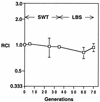Contribution of pilA to competitive colonization of the squid Euprymna scolopes by Vibrio fischeri
- PMID: 12571000
- PMCID: PMC143614
- DOI: 10.1128/AEM.69.2.820-826.2003
Contribution of pilA to competitive colonization of the squid Euprymna scolopes by Vibrio fischeri
Abstract
Vibrio fischeri colonizes the squid Euprymna scolopes in a mutualistic symbiosis. Hatchling squid lack these bacterial symbionts, and V. fischeri strains must compete to occupy this privileged niche. We cloned a V. fischeri gene, designated pilA, that contributes to colonization competitiveness and encodes a protein similar to type IV-A pilins. Unlike its closest known relatives, Vibrio cholerae mshA and vcfA, pilA is monocistronic and not clustered with genes associated with pilin export or assembly. Using wild-type strain ES114 as the parent, we generated an in-frame pilA deletion mutant, as well as pilA mutants marked with a kanamycin resistance gene. In mixed inocula, marked mutants were repeatedly outcompeted by ES114 (P < 0.05) but not by an unmarked pilA mutant, for squid colonization. In contrast, the ratio of mutant to ES114 CFUs did not change during 70 generations of coculturing. The competitive defect of pilA mutants ranged from 1.7- to 10-fold and was more pronounced when inocula were within the range estimated for V. fischeri populations in Hawaiian seawater (200 to 2,000 cells/ml) than when higher densities were used. ES114 also outcompeted a pilA mutant by an average of twofold at lower inoculum densities, when only a fraction of the squid became infected, most by only one strain. V. fischeri strain ET101, which was isolated from Euprymna tasmanica and is outcompeted by ES114, lacks pilA; however, 11 other diverse V. fischeri isolates apparently possess pilA. The competitive defect of pilA mutants suggests that cell surface molecules may play important roles in the initiation of beneficial symbioses in which animals must acquire symbionts from a mixed community of environmental bacteria.
Figures






References
-
- Altschul, S. F., W. Gish, W. Miller, E. W. Myers, and D. J. Lipman. 1990. Basic local alignment search tool. J. Mol. Biol. 215:403-410. - PubMed
-
- Bittinger, M. A., J. L. Milner, B. J. Saville, and J. Handelsman. 1997. rosR, a determinant of nodulation competitiveness in Rhizobium etli. Mol. Plant-Microbe Interact. 10:180-186. - PubMed
-
- Boettcher, K. J., and E. G. Ruby. 1994. Occurrence of plasmid DNA in the sepiolid squid symbiont Vibrio fischeri. Curr. Microbiol. 29:279-286.
Publication types
MeSH terms
Substances
Associated data
- Actions
- Actions
Grants and funding
LinkOut - more resources
Full Text Sources

